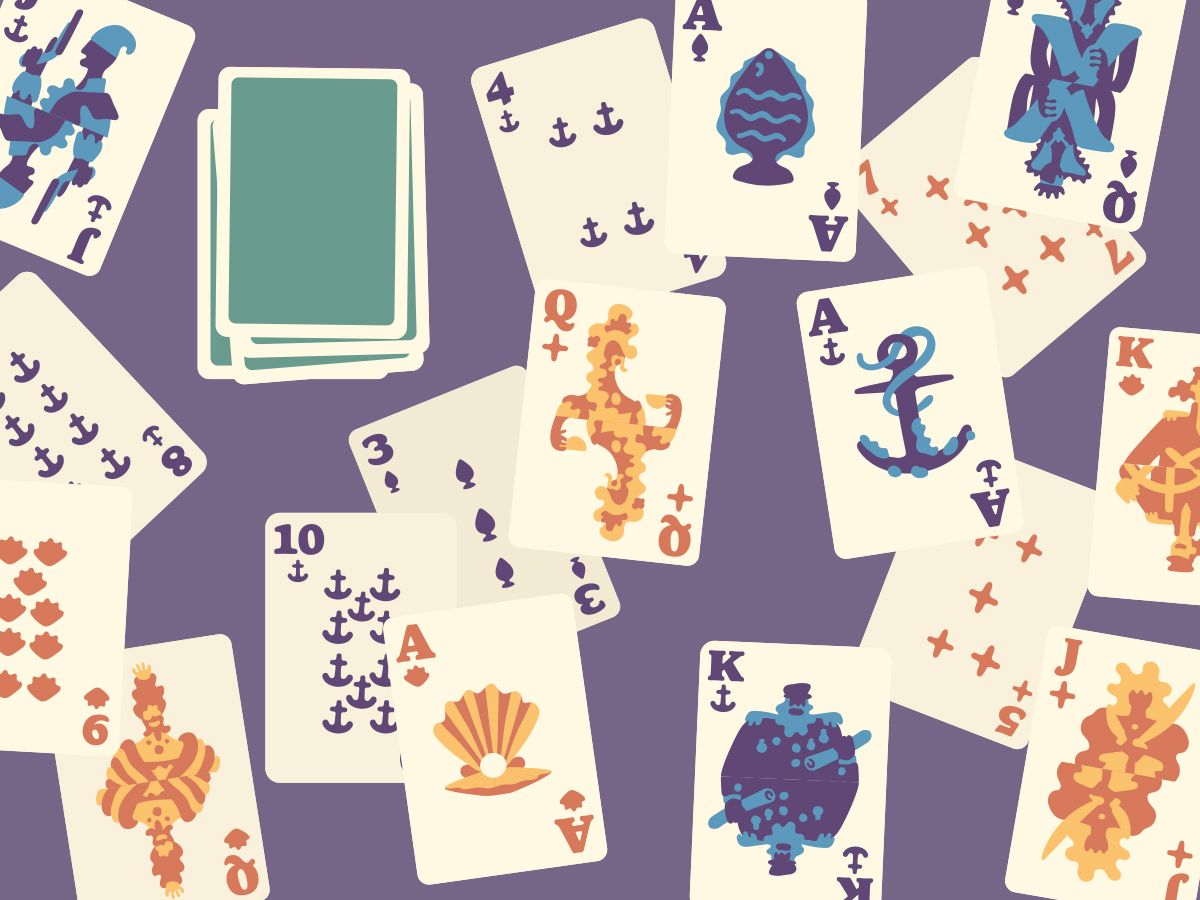
Spoils - A Development Retrospective
In this post, Ben Wilson (Creative Producer), Daria Radu (Card Game Programmer) and Doug Wilson (Card Game Design) sit down to talk about a part of Saltsea Chronicles they all worked on together: Spoils (the card game set in the world of Saltsea).
Creative Producer Ben Wilson invites programmer Daria Radu, and designer Doug Wilson, to tell the in-depth story of how Spoils came to be, and share some insights into the development process.
Ben: Doug, as the person who’s been here at the studio the longest of the three of us, can you recall where the initial idea for including a card game within Saltsea came from? What were the earliest influences?
Doug: I teach a non-digital games class, so obviously I’m personally invested in card games, both in terms of my own playing history but also professionally. I was really inspired by Zachtronics, who design a custom designed Solitaire game for each of their games.
I certainly grew up with a number of trick-taking card game classics, including Hearts and a Dutch and South African game called Klaverjas. Thinking about the long history of card games like Whist, Euchre, Bridge, etc., I might posit that the “trick” is the single most important tabletop mechanic of all time. So it felt like a natural genre for us to explore.
Then, during COVID lockdowns, my partner and I got really into the recent co-op trick-taking game The Crew, playing our own custom implementation via playingcards.io, together with our friends Nina and Nico. That was a really formative experience for me, especially since the game continues to add new rules, variations, etc. (Ben and I also recorded an Eggplant podcast episode about that game, here).
Compared to more traditional competitive trick-taking games, The Crew intensifies this feeling of solving a puzzle, which I knew would be relevant for our game, in which you’d be playing alone against AI opponents.
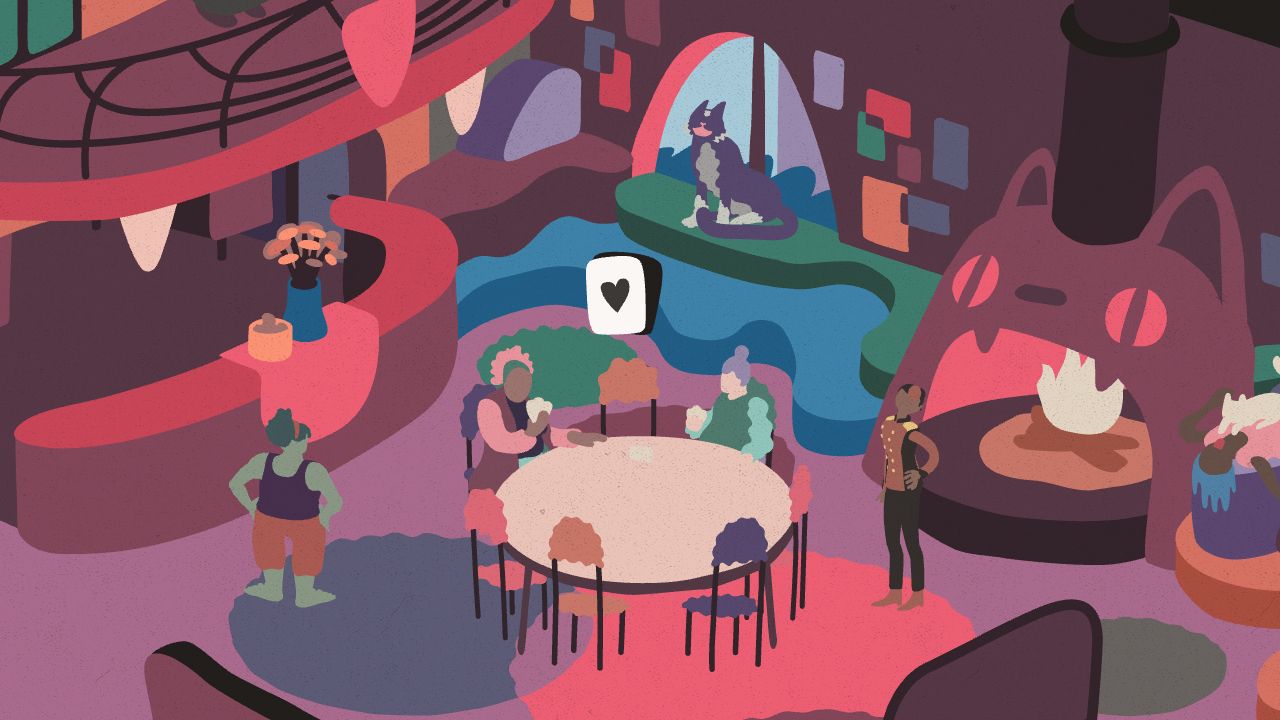
Ben: And why did it feel like it was so important to include a minigame in Saltsea Chronicles?
Doug: I was mindful that the game we were pitching would centre around reading text. In those kinds of games, I feel like it’s useful to change up the pacing and provide an alternative activity that tickles another part of the brain.
Ben: Daria, before you fully joined DGF as a part of the programming team you originally came on board as one of two ITU placement collaborators, working on a thesis project. What was your early impression of Saltsea when you arrived?
Daria: I joined Die Gute Fabrik at a very exciting time for Saltsea Chronicles, as it was somewhere between the early prototypes and the development of the very first chapter which meant there was still so much creative freedom.
The world building for Saltsea Chronicles had always been extremely robust and detailed thanks to the work of our great writers’ room, and joining felt like being immersed into a whole new world of beautifully crafted communities. And these communities needed a card game!
For me, this was my first dive into the real-life development of a commercial game that would be released to real players. This meant I needed to learn the ropes of the game’s production cycle, and also take more responsibility over decisions that were to be made in this project.
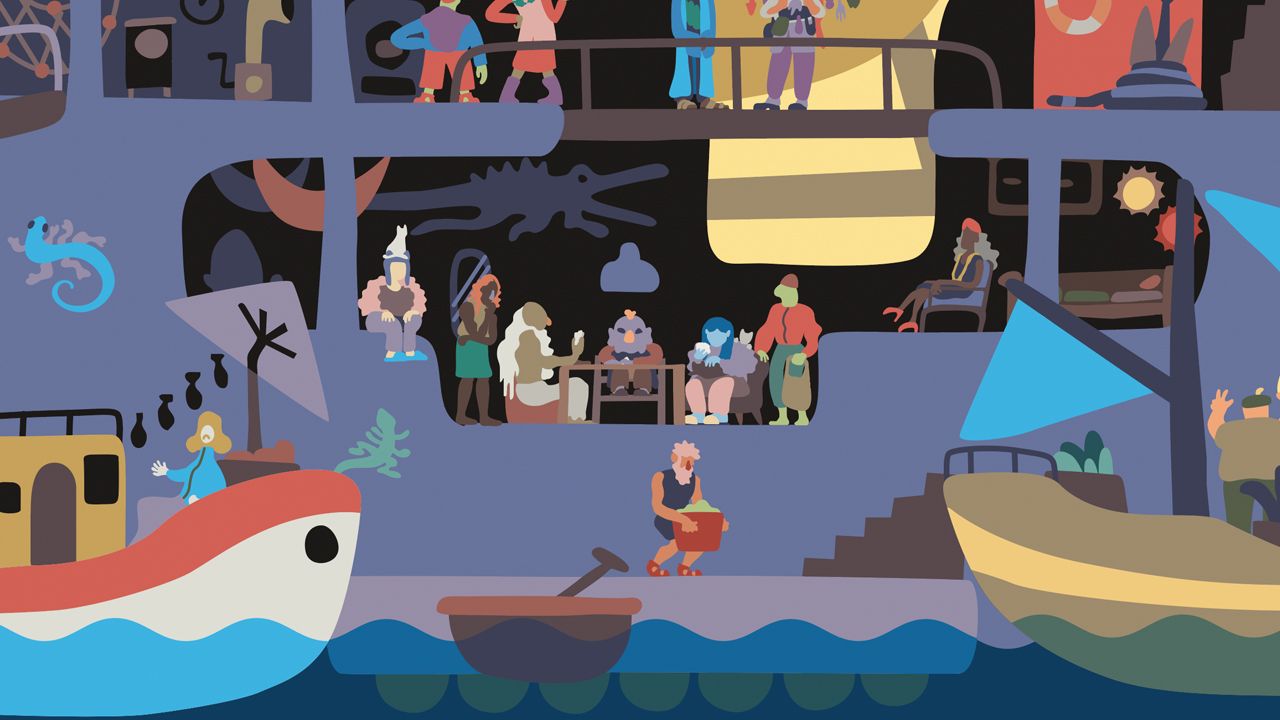
Ben: When you came on board, we thought that having both of you assigned to a relatively self-contained part of the game would be the best way to give you some space on the project, and it would let things move on a different schedule to the rest of the game (which by that point was moving into Vertical Slice production). Was there anything in particular that appealed to you about being involved in this particular part of the project?
Daria: I have always been very interested in working with artificial intelligence in games, and doing that inside a card game was instantly appealing to me. The main reason is that, unlike a lot of other types of board games, card games are games of “imperfect information”.
Chess is, for example, a game of perfect information - you always know the full game state by just looking at the board, and that information is available to all players at all times. In card games however, one does not have access to the hidden hands of the other players, making that an unknown variable of the game state. Hence the imperfect information.
The best part about joining at such an early stage was that the card game was merely an idea - so there was so much room for experimenting.
My placement was together with game designer Alexandra Labusová, so we worked together a lot in defining the final rules of the card game, and by building lots of prototypes.
Note: Daria and Alexandra both wrote blog posts for the site to introduce themselves when they joined in 2021!
Ben: Speaking of the game as just the seed of an idea, now seems like a good time to talk about the initial design and prototyping process. Do either of you want to talk about how we went about paper prototyping and iterating on the original ruleset?
Doug: The process started with Ben and I researching, playing, and discussing famous trick-taking games. I believe we tried Hearts, Bridge, Oh Hell, Bourré, 500, The Crew, and more. The studio works fully remotely, so we used playingcards.io (what a godsend!) to play as a group.
At some point, Ben and I started brainstorming our own ideas for core mechanics. At that early stage, we weren’t really looking to draft full rulesets, we were searching for just one overarching idea that would catch fire.
Looking over my notes from the time, I proposed some half-baked ideas like:
- If you break from the Lead suit, *everyone* has to stick with that suit if possible
- Anti-trump suit? Clubs always *loses*, even as a Lead suit
- Alt win condition: you *lose* if you win too many Jacks?
Ben: One of the advantages to making a card game that became immediately clear to me is that it was so easy to just boot up a virtual card game table, deal out a deck of regular playing cards and try out a new ruleset.
This was definitely the fastest turnaround I’ve had working in games, to take an idea from paper design to playable form. It meant we could try basically anything, so long as we had the time to get together and playtest it.
Doug: We also knew pretty quickly that we wanted to make a 2v2 game like Bridge or 500. The 2v2 format perfectly matches the expedition structure of the game, where you bring exactly two of your crew members to each chapter’s location. I’ve also long been a fan of 2v2 games since publishing Hokra as part of our local multiplayer compendium, Sportsfriends.
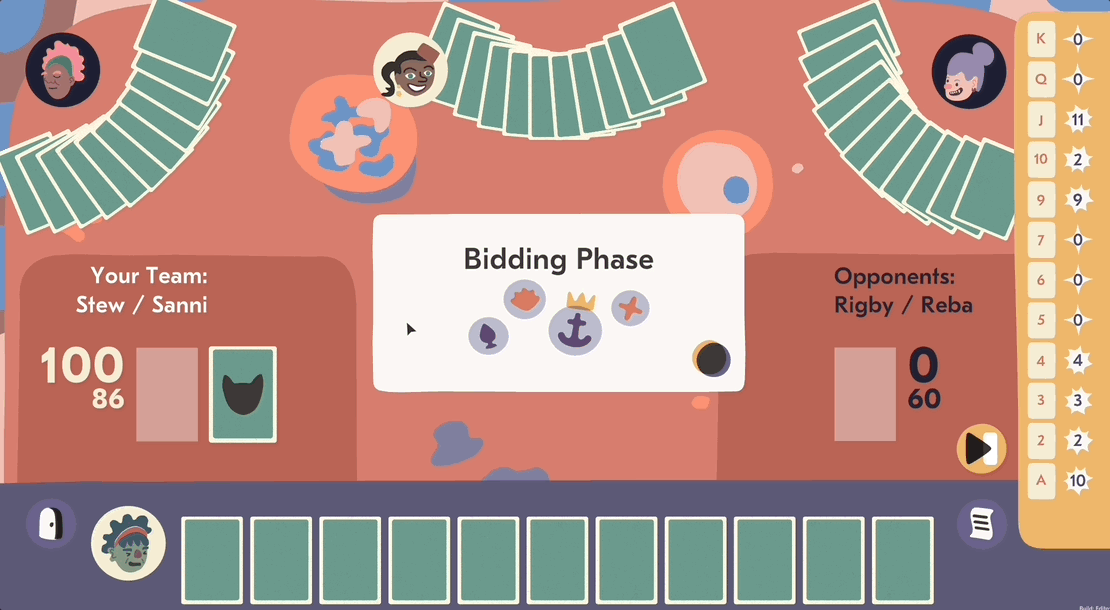
Ben eventually proposed the winning idea, inspired by the cultural politics and history of Saltsea Chronicles: when you win a trick, the winning card is scored by the other team.
Immediately, it was clear that this was a pretty brilliant idea, on two different accounts: first, it echoed the values of the in-game world, in which more collectivist societies are very aware of the greed and hoarding that led to cataclysm; second, the idea just felt novel and brain-bending, in a way that fit the puzzle-solving vibes we were aiming for.
As it turns out, there was a trick-taking game published in 1997, David & Goliath, that uses a similar mechanic. I only discovered this much later doing more research into trick-taking games.
Once we had the core mechanic in place, it almost felt like the rest of the game “designed itself”, in that we could pretty readily address all the immediate questions by adopting ideas from other trick-taking games.
First, in order for the mechanic to make sense, we knew that different cards or different combinations would need different point values, like in games such as Pinochle or Briscola Chiamata.
Actually, Briscola Chiamata was probably the most important touchstone here, in that the relationship between rank and value is purposefully erratic. For instance, a Three is worth 10 points, whereas a King is only worth 4 points.
This was perfect for our game, Spoils, in which we knew it should sometimes be dangerous to play a high card. In Spoils, the King and Queen are high ranking cards that are worth 0 points, and are therefore “safe” to win a trick with.
But the Jack is worth 11 points, and so you have to be very careful around that card, otherwise you might give your opponents those points! Meanwhile, the lowest ranked card, the Ace, is worth 10 points. We knew we wanted to incentivise partner play, i.e. feeding a low-ranked, high-value card to your partner.
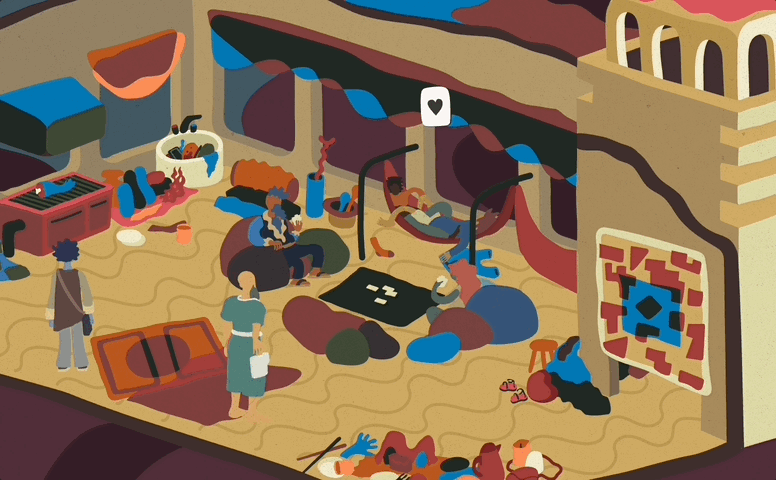
Ben: For me, the day you suggested playing with the relationship between card rank and point value was the moment it all slid into place in my head and I could see the potential of what we could do with Spoils as a novel puzzle-y game experience. It playtested really well too.
While this was going on, Daria and Alexandra were working in parallel on the problem of how to represent all of this as a digital game, and all of the design considerations attached to that.
Making a video game version of a card game means having to think about unique issues around UI, game flow, legibility, and making an interface that supports multiple input methods.
On the positive side though, there are also certain affordances that the video game format offers, such as automatic scorekeeping and the resolving of who wins each trick. These are elements that the team knew would take some of the burden off of the job of tutorialising the game, as the player would be able to, at the very least, learn the flow of the game just by watching it in motion.
Daria: Our role was to build upon Ben and Doug’s ideas, and see how they would translate into a practical space - that meant breaking down the game into smaller pieces, figuring out which parts of the game we can convey to players more easily by using tooltips, tutorials or table placement.
It was very important to us to make the game’s rules accessible to players, so Alexandra’s work was more geared towards “tutorialisation” of the card game. That is why it was important to have guest players in our playtesting sessions.
For me, my angle was more towards how it would be best to translate a 2v2 game into one that is played by only one human player. We explored a lot the possibility of the player controlling two hands at once - which ended up not being a very successful approach in playtesting - and as that fell, prototyping was a lot about figuring out how to evoke the team feeling into the digital space as well.
Ben: The last major design problem we had was the question of how to control for randomness. Players always need to have valid strategic options no matter the hand they’ve been dealt.
In many of the games we researched, this problem is solved through a bidding phase where each player bids on how well they think they’ll do, and their winnings or score are adjusted based on that initial bet. For Spoils, we settled on a phase where each team bids on a suit to be the more valuable “sweeper” suit. This phase is important, as it gives players a way to influence how good or bad their randomly dealt hand is.

Doug: But wagering isn’t the only way to control for randomness. Some games add alternative win conditions. Hearts is a great example - in that game, you can do what’s called “shooting the moon” if you play perfectly badly and manage to win all the bad cards. In other words, if you draw really unlucky cards, you can sometimes go all in on trying to lose badly enough to win.
Another example of this solution is the two-player trick-taking game The Fox in the Forest, which has a “Greedy” mechanic where your opponent scores points if you win too many tricks.
Inspired by that mechanic, we added a “Hoarding” mechanic to Spoils, named after the myth of the Hoarders who brought the cataclysm that flooded the world. In Spoils, if you score over 100 points, points are swapped and your team actually loses.
Daria: For me, the most difficult part to figure out design-wise was the bidding phase of Spoils.
Bidding is extremely complex in most trick-taking card games, and it’s usually the phase that players use to communicate hints towards their partners. This phase can sometimes last for several rounds, and it can get very strategic.
The first hurdle we faced in our bidding AI development was “how can we make your partner convey to you its current strongest suit, without it being too obvious for the opponents?”.
The rules for the bidding phase took the most time for us to settle on, after trying out myriads of rules and variations inspired by other trick taking card games. And even afterwards, building the AI model that powers it proved to be even more challenging from the logical perspective - especially factoring each of the variants. We even had to scrap a full iteration of the model!
But the final product is definitely one that we are proud of, and we hope players enjoy the bidding phase of Spoils just as much as the rest of the round.
Ben: Just to add on to that, one of the priorities we had when it came to designing the bidding phase was to make something that had a similar flow to it to the rest of the game. We thought Spoils would be more legible and easy to learn if the action we were asking the player to take in this phase was the same action we ask of the player during the rest of the game i.e choosing a single card to play from your hand.
Throughout the design process, I worried a lot about the cognitive weight of constantly presenting the player with drastically new elements and flows. We were already intending to introduce twists to the base rules with the game variants, so we didn’t want to overload and overwhelm players.
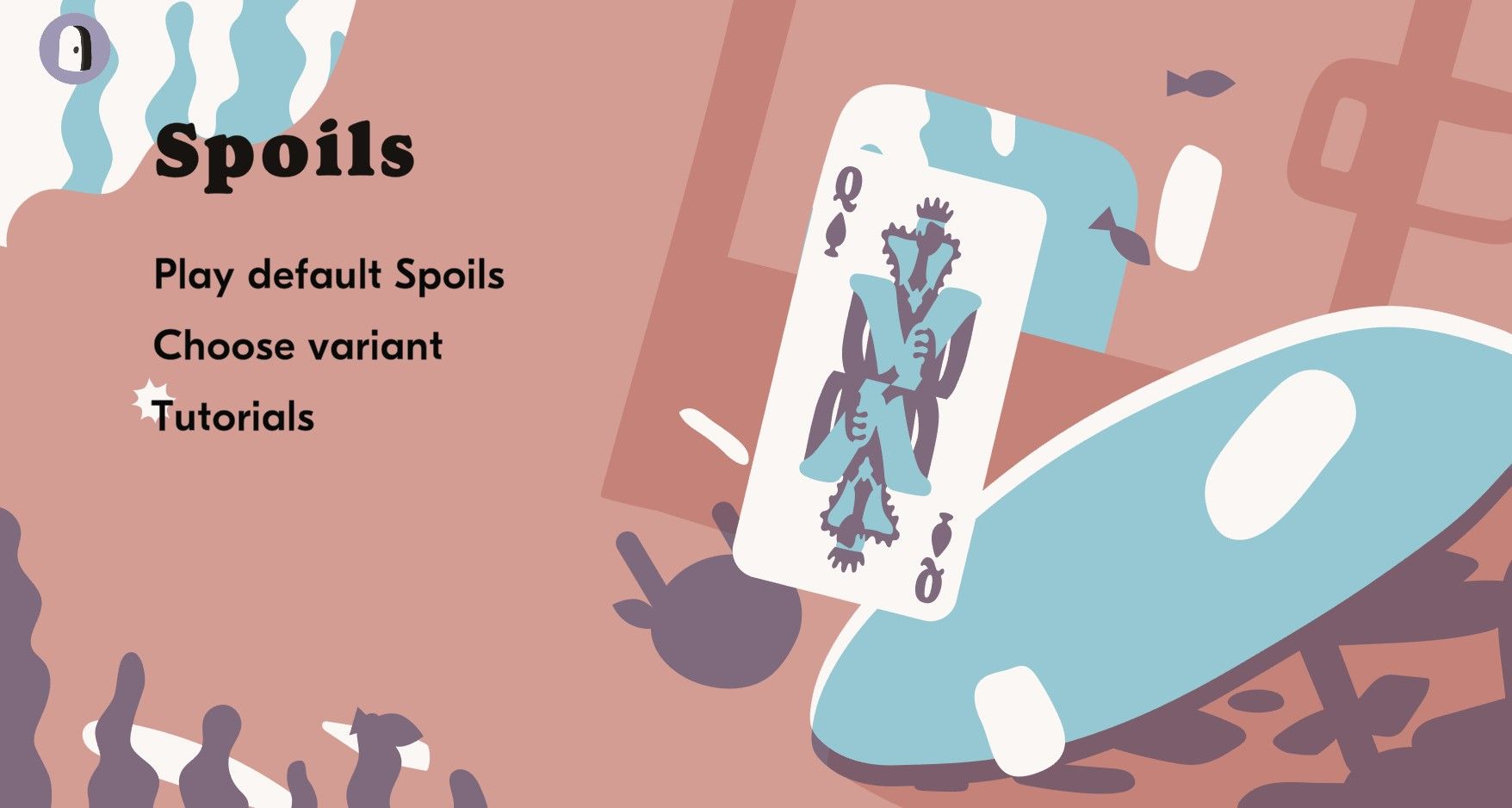
My internal guideline was that we should keep the flow of the game as consistent as possible, to make more cognitive room for the rule variants. The aim was for players to be occupied with the strategic puzzling, and not distracted with unsureness over what they should be clicking on at any given time.
Ben: Do either of you remember anything notable from those early stages that didn’t make the cut? There were so many directions we ended up not going in, and variants that didn’t work out for one reason or another.
Doug: Very early on we brainstormed lots and lots of half-baked ideas. But of all the initial more fleshed out variants we proposed, only one was fully cut. I had called it “Sink or Swim”, and the idea is, points would go to individuals instead of the team. Then, at the end of all three rounds, the team with the lowest-scoring player would lose. So, unlike in regular Spoils, you’d now have to be concerned about splitting points evenly.
The only other bit of work I’d like to shout out is The Deck of the Flood - a world-building document written by one of our writers, Harry Josephine Giles. The document was actually written before we designed Spoils, and it proposes the history, mechanics, and meanings for a tarot deck commonly used within the world of Saltsea Chronicles.
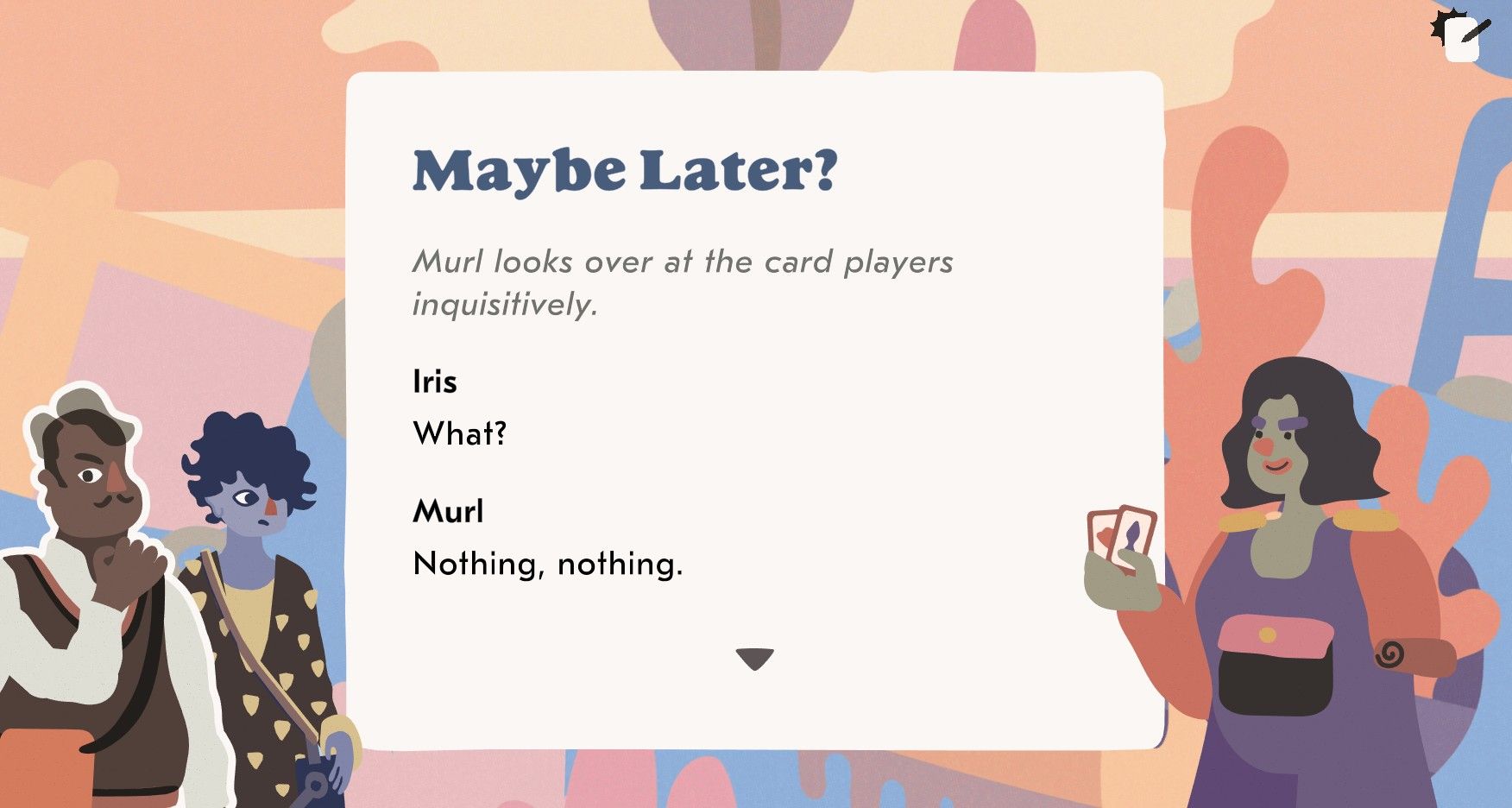
Josie’s document is so rich and I wish we could have used more of it, but time was short and there were just too many gameplay demands on the Spoils idea as we had developed it.
Ben: We went through several phases of playtesting for Spoils. I remember at a certain point we were sending around special builds of the game that only had the card game in it, so that we could gather more feedback to help steer the latter half of development. What was your reaction to the playtests? What were you most eager to hear about from the folks who tested for us?
Daria: One lesson that we learned repeatedly as we playtested was that people have very different levels of experience with trick taking card games. Some may have never played one, some may have limited experience, and some may be avid trick taking card game players. And all of these players approached our game in a different way, and had different learning curves.
Our main priority was to work as much as possible towards easing the learning process of Spoils - to the best of our resources. We hope that the tutorials - which are always available in-game for players to revisit - are a good way to encourage as many players to try out Spoils as possible.
Ben: The layered approach we took to our tutorial was pretty much entirely a result of observing this, and trying to come up with something that gave players of different experience levels an appropriate onramp to start playing.
Doug: One of the main things I personally was looking for from the playtests was feedback on how it feels to play the game with an AI partner. It’s one thing to play against AI opponents, but in a pairs game, it’s even more critical to feel like you can puzzle out each trick together with your partner.
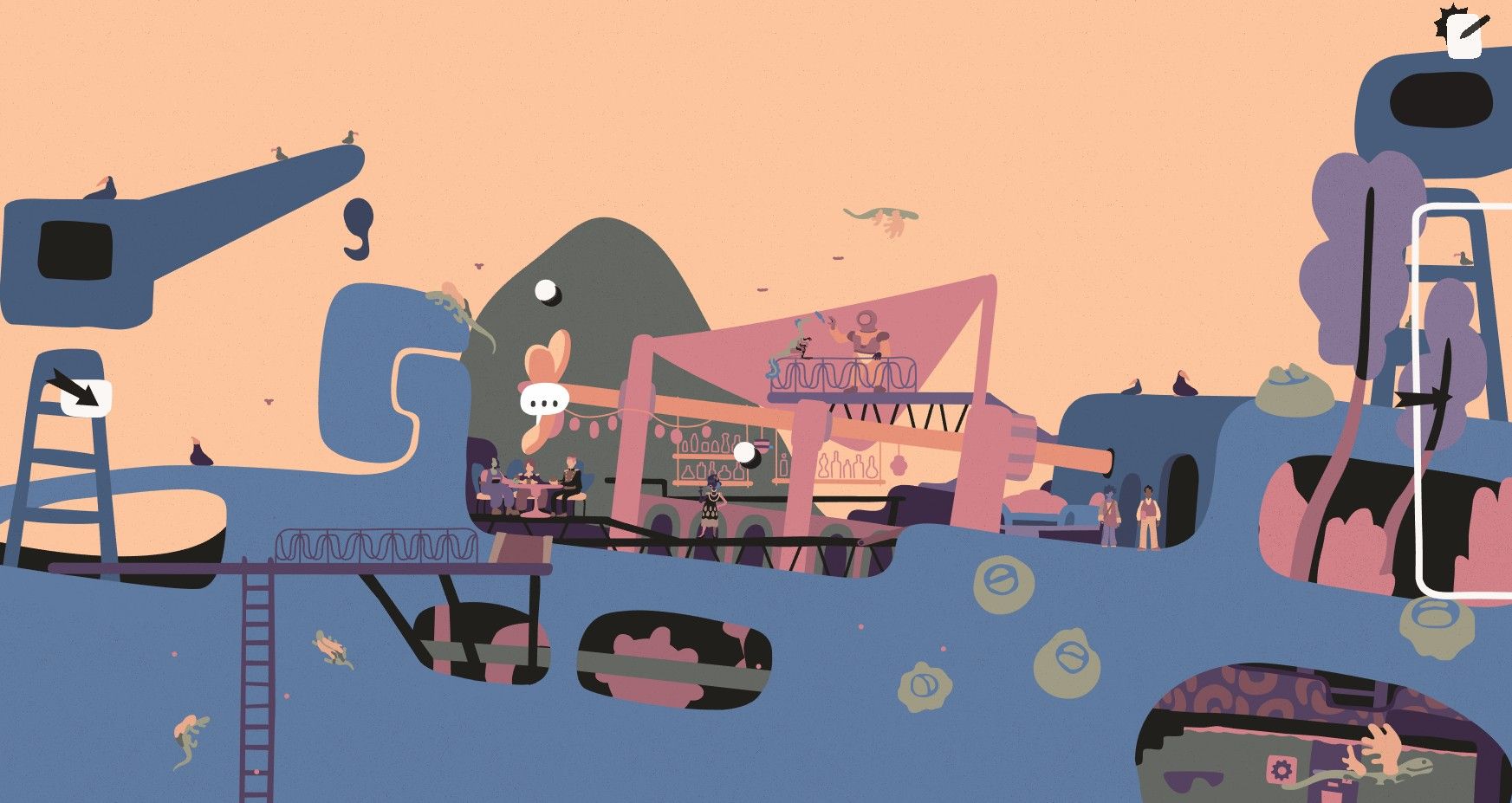
In retrospect, this was a very tall order, and way more scope that we had initially appreciated. We’re very fortunate to have had Daria on the team, who did such a good job with it. All the AI players are controlled by hand-authored machine learning algorithms, and so based on the playtest feedback, Daria and I talked through how we should tweak some of the system rules, especially around bidding.
Daria: An interesting find from the playtests was that players will more often than not pay the most attention to their partner and how they are playing, and this was an important point that we developed further into our model. It was important for us that the game felt strategic, and that your AI partner was seen as an enhancement, not an impediment to your efforts.
Doug: Another lesson we took away from the playtests was that the character “barks” were important in terms of making the AI players feel more natural. Occasionally, one of the AI players will utter a short sentence or reaction (via a text bubble) based on a whole bunch of game situations we identified and parameterised.
Even these short texts help provide some narrative reasons for why a player may have chosen the card they did. Even if you feel like it’s clear that your partner made a mistake and played an inadvisable card, that can feel like part of the intended challenge if you get the sense that your partner is kind of a goofball.
Ben: Outside of designing the rules and implementing the game logic, there was also attention paid to the theming of Spoils, which influenced a lot of our decisions such as ideas for variants, the visual design of the deck and more. Talk a bit about this process, and maybe some highlight moments of making the card game fit within the world of Saltsea.
Daria: This part of the process was the most fascinating to me as it required a lot of cross-disciplinary work from our teams, from writing to art to programming. It was very important that Spoils reflected the world in which it is played, and that can be seen already from its rules. One of the core rules of Spoils is “Hoarding” - if you accumulate too many points, you lose the round. This ties in to the way communities work in Saltsea Chronicles, in which resources are spread to the people and hoarding is viewed in a negative light.
Then you get to the deck, which builds upon the standard 52-card deck, but instead its suits are new symbols that represent various common objects that are part of the world (fish, stars, anchors and shells).
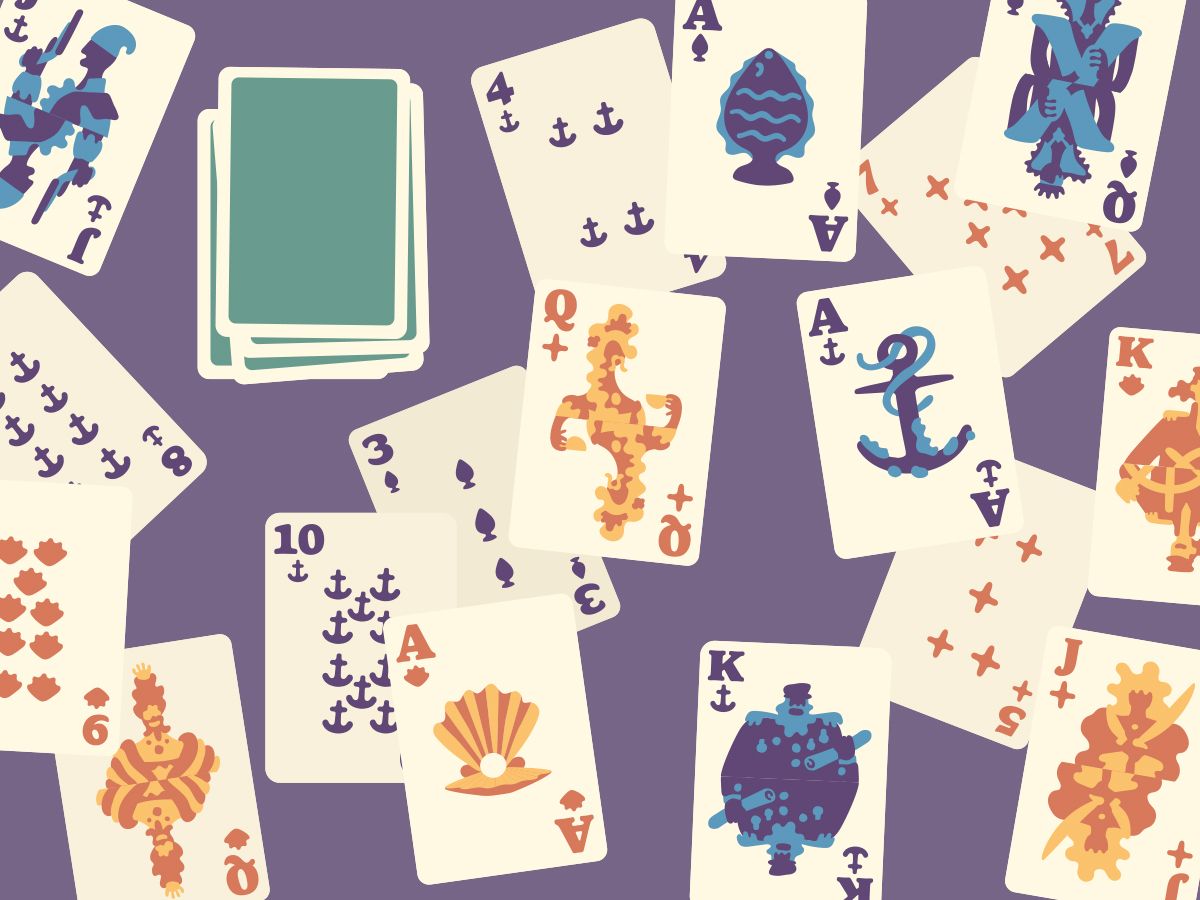
Doug: Beyond the game itself, early on I knew early on that game design itself could be a key site where we could do world-building. As part of my PhD, which I did as a New Jersey raised kid living in Copenhagen, I got really interested in how games reflect their cultural contexts.
Living in Denmark, I learned that in collectivist cultures, traditional games are often played to have one loser, rather than one winner. For example, compare Synd, Danish Liar’s Dice, against Liar’s Poker as played in the USA. It’s kind of the same game, but with opposite endgames. Which is to say, our very ideas of “winning” and “losing” are highly situated (this is not surprising to any sociologist, of course).
The practice of “house rules” is a big idea I discuss in my intro game making class, and is obviously a conceptual cornerstone of party games I’ve worked on like J.S. Joust and B.U.T.T.O.N.
The archipelago setting of Saltsea Chronicles lends itself to the idea that different islands might play this common card game slightly differently. The closest parallel I could think of is Triple Triad in Final Fantasy 8, but we wanted to take some of those ideas even further, politically and intellectually. We definitely wanted to play up this idea that the “puzzle” of the card game would change on each island you visited, and that hopefully this would help drive home the realisation that these communities evolve their own unique values.
Ben: What part of Spoils are you most excited about for people to experience when Saltsea Chronicles releases to the public?
Daria: I am very excited to see how people approach the game, and what strategies they come up with! Spoils is a fascinating game to me, and I know that people will find so many different ways to play it (some maybe even more competitively than others).
And I hope the AI we have created will help enhance that! It’s very important to know that it’s not meant to be the “absolute opponent” - but instead it’s there to create an enjoyable, casual gaming experience for all players.
Doug: Most of all, I hope some people try the game with their friends, outside of Saltsea Chronicles! Very intentionally, Spoils is based on a standard 52 card, four-suit deck that is widely available.
As good a job as Daria did with the AI, it’s even more rewarding to play this kind of partner game with old friends, in person or even remotely on playingcards.io.
Wishlist Saltsea Chronicles on Steam here.
Set in a post-flood world, Saltsea Chronicles allows you to guide a misfit crew in search of their missing captain. The investigation and the decisions you make will see you explore a series of beautiful and intriguing islands, meet different communities, and see the lives of people built on the ruins of what came before – all as you unravel the mystery at the heart of the game.
Saltsea Chronicles will be coming to PlayStation 5, Nintendo Switch and PC later this year. Watch our reveal trailer right here!
To find out more about the game head to the dedicated website saltseachronicles.com. And follow us on Twitter, Instagram and TikTok as we begin to share more about the game in the run up to launch.
